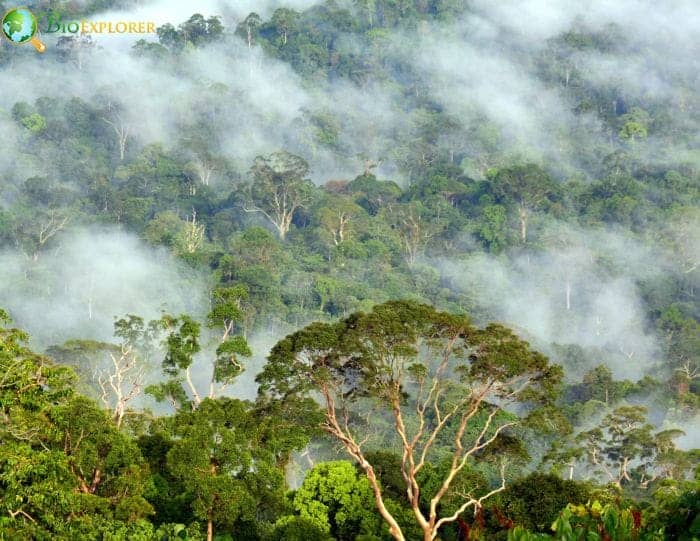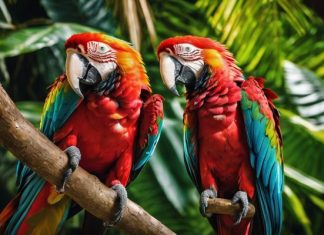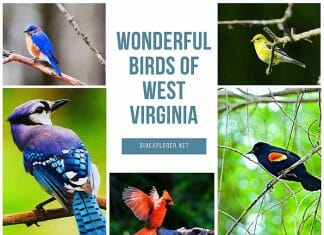Top Rainforests In The World: Rainforests are considered as the planet’s oldest ecosystems. Rainforests are called such because of the vast amounts of annual rainfall they receive. Because of their almost stable climate, rainforests offer many species of biodiversity.
Regarding rainforests, everybody knows about the Amazon, the most significant tropical rainforest in the world. However, there are still a lot of other rainforests out there, many of which are unknown to the general public.
The good thing is that this article lists the world’s most spectacular rainforests from different continents.
Table of Contents
- Top Rainforests in the world
- 1. Pacific Temperate Rainforest (North America)
- What Animals Live In Rainforests?
- 2. Hoh Rainforest (North America)
- 3. Tongass National Rainforest (North America)
- 4. Amazon Rainforest (South America)
- 5. Central Suriname Nature Reserve (South America)
- 6. Iguaçu National Park (South America)
- 7. Congo Rainforest (Africa)
- 8. Sapo National Park (Africa)
- 9. Sutjeska National Park (Europe)
- 10. Borneo Lowland Rainforest (Asia)
- 11. Khao Sok National Park (Asia)
- 12. Bhagwan Mahaveer Sanctuary and Mollem National Park (Asia)
- 13. Tasmanian Temperate Rainforest (Australia)
- 14. Daintree Rainforest (Australia)
- Rainforests of Southeast Asia
Top Rainforests in the world
1. Pacific Temperate Rainforest (North America)

The first rainforest in this list is thePacific temperate Rainforest located in the eco-region of North America. The rainforest consists of five sub-regions: The Queen Charlotte Islands, Northern Pacific coastal Forests, British Columbia coastal forests, Northern California coastal forests, and Central Pacific coastal forests.
- The large total area of these sub-regions makes the whole Pacific Temperate Rainforest the largest temperate rainforest in the world.
- The Pacific Temperate Rainforest contains a lot of giant redwood trees and thus results in being called the “Coast Redwood Zone“.
What Animals Live In Rainforests?


2. Hoh Rainforest (North America)

Located on the Olympic Peninsula, the Hoh Rainforest is one of the few ecosystems in the world that has remained unchanged even for a thousand of years. Because of this, it has been awarded by UNESCO as a “World Heritage Site and a Biosphere Reserve.“
- Most parts of the rainforest are covered with hanging ferns and mosses. Trees like Western Hemlock and Sitka Spruce are commonly found in the area.
- During winter, rain falls almost frequently, and the amount of rainfall can reach up to 170 inches of precipitation per year.

3. Tongass National Rainforest (North America)

Known as the United States’ largest national rainforest, Tongass National Rainforest covers the majority of Southeast Alaska and is roughly the size of West Virginia.
- Tongass National Rainforest is the world’s largest intact temperate rainforest, filled with numerous salmon streams. Because of this, animals like salmons, eagles, wolves, bears, and even whales can be found in the area.
- The rainforest is bordered by the Canadian Border and the Coast Mountains on the East and the Pacific Ocean on the west.
Suggested Reading:
Wonderful Birds of West Virginia

4. Amazon Rainforest (South America)

As mentioned in the introduction, the Amazon Rainforest is the most abundant tropical rainforest in the world, with a wide variety of ecosystems like savanna and swamps can be found.
- Covering much of the Amazon Basin, the rainforest itself is very diverse with numerous species of plants, animals, and even micro-organisms are found.
- The vast rainforest covers parts of Brazil, Colombia, Peru, Venezuela, Bolivia, Ecuador, and other countries. It is believed that the Amazon Rainforest is almost twice the area of India.

5. Central Suriname Nature Reserve (South America)

The next rainforest in this list is the Central Suriname Nature Reserve found in west-central Suriname in South America. This nature reserve comprises almost 1.6 million hectares of tropical rainforest with various ecosystems.
- This place is home to multiple animal species, which include the giant armadillos, river otters, sloths, harpy eagle, tapirs, jaguars, and species of primates. About 5,000 species of vascular plants can also be found here.

6. Iguaçu National Park (South America)

Known for its massive waterfalls, Iguaçu National Park in Misiones Province, Argentina is considered as one of the most visually and acoustically magnificent national parks in the world.
- The rainforest is also home to over 1000 species of plants that serve as habitats to animals like the howler monkeys, jaguars, and tapirs. Aside from its stunning waterfalls and wildlife, the national park is beside the remnant of one of the world’s most threatened global conservation sites, the Atlantic forest.
- It was included in the list of World Heritage Sites in 1984.

7. Congo Rainforest (Africa)

Also known as the Congo Basin, the Congo Rainforest is regarded as the second largest tropical rainforest (next to Amazon Rainforest) in the world. The whole area is so vast that it is thought to be larger than the state of Alaska.
- The rainforest traverses the countries of Central African Republic, Congo, Cameroon, Gabon, and Equatorial Guinea.
- The Congo Basin is home to various wild animals such as buffalos, gorillas, chimpanzees, bonobos, and elephants.

8. Sapo National Park (Africa)

Located in Liberia, West Africa Sapo National Park is the second largest tropical rainforest in the continent.
- Due to a lot of species that can be found in this area, this park is considered a biodiversity hotspot. Some of the species that can be found here are the pygmy hippos and forests elephants.

9. Sutjeska National Park (Europe)

Perućica is a part of the Sutjeska National Park located in Bosnia, the oldest and the largest national park in the continent. Perucića is highly conserved because it is one of the last ancient rainforests in Europe.
- The rainforest reserve, a UNESCO-recognized site, has a total area of 1400 hectares. It is home to vegetation that is believed to be 300 years old.

10. Borneo Lowland Rainforest (Asia)

Considered as an ecoregion of Borneo in Southeast Asia, the Borneo Lowland Rainforest serves as a home to more than 15,000 animal species and almost 10,000 plant species.
- This rainforest has a very stable climate and an average rainfall of 8 inches per month. It also has a constant temperature of 18 degrees Centigrade.
- At present, this jungle is at risk of biodiversity loss due to excessive illegal logging, hunting, and land conversion for agriculture and commercial expansion.

11. Khao Sok National Park (Asia)

Located in the southern region of Thailand, the Khao Sok National Park consists of the country’s largest area of virgin rainforest. This national park is also considered one of the earliest evergreen rainforests that have ever existed.
- This park serves as a home to various animals, which include elephants, deer, tapirs, macaques, wild boars, and porcupines.
- Like many national parks, the Khao Sok National Park is a tourist site. Thai people believe that aside from bringing money to its natives, this makes more people aware of the importance of rainforests.

12. Bhagwan Mahaveer Sanctuary and Mollem National Park (Asia)

The next rainforest in this list is the Bhagwan Mahaveer Sanctuary and Mollem National Park, which is located in Western Ghats, India. The national park contains some of the world’s most diverse flora and fauna.
- Various species of animals can only be found in the rainforest. Such include the rhesus monkeys, Bengal tiger, and Indian king cobra, multiple species of hornbills, pigeons, laughing thrushes, and crocodiles.
- Locals typically use the wet regions in the rainforest for planting tea and eucalyptus.

13. Tasmanian Temperate Rainforest (Australia)

The next rainforest in this list is the Tasmanian Temperate Rainforest in Australia. This temperate rainforest is unique because, unlike other temperate rainforests, it is abundant with lichens and mosses instead of the usual orchids and vines.
- With almost 10% cover, Tasmania contains the continent’s largest temperate rainforest. The climate in this place makes it hard for plants like vines, lianas, palms, and buttresses to grow.

14. Daintree Rainforest (Australia)

Located in Australia, the Daintree Rainforest is known as one of the three oldest rainforests (about 165 million years old) in the world. This rainforest is located near the Cape Tribulation and the Great Barrier Reef.
- This place is home to about 600 vertebrates and more than 1000 species of insects.
- Interestingly, the Daintree Rainforest became the inspiration for the movie Avatar.

Rainforests of Southeast Asia
Lowland Rainforests of Malaysia

The lowland rainforests of Malaysia are located on the Malay Peninsula, as well as the island of Borneo, which Malaysia shares with Indonesia and Brunei. These lush rainforests grow in the hot and humid climate of the equatorial region and receive over 2,500 mm of rainfall annually.
Some key features of Malaysia’s lowland rainforests include:
- Diverse mix of trees: Over 2,500 species of trees have been recorded in these rainforests. Some of the most impressive trees include the kapur (Dryobalanops), which can grow over 60 meters tall, and the jelutong (Dyera costulata), which was once highly valued for its latex. Other predominant trees include meranti (Shorea), resak (Vatica), and keruing (Dipterocarpus).
- Wealth of wildlife: The rainforests are home to endless wildlife, including mammals like orangutans, tigers, elephants, tapirs, sun bears, and gibbons. Impressive bird species include several species of hornbills and the Rhinoceros hornbill, which has a huge colorful beak. Reptiles range from king cobras to flying lizards, while insects include one of the world’s largest butterflies, the Rajah Brooke butterfly with a 25cm wingspan.
- Extensive peat swamp forests: Malaysia hosts some of Southeast Asia’s most extensive peat swamp forests, mainly on the island of Borneo. These waterlogged forests contain deep deposits of peat formed from decaying plants over thousands of years. The peat swamps are home to unique species like the proboscis monkey.
- Severe deforestation: Unfortunately, Malaysia has suffered some of the world’s highest deforestation rates in recent decades due to extensive logging and plantation agriculture. Over 70% of the Peninsular Malaysian rainforests have been logged, while only around 50% of Borneo‘s forests remain intact. Better conservation and forest management practices are urgently needed.
Some initiatives seeking to protect Malaysia’s rainforests include the Heart of Borneo initiative, transboundary conservation efforts with Indonesia and Brunei, and the creation of protected areas like Taman Negara National Park and Endau Rompin National Park. But continued action is critical for saving these precious rainforests and their wealth of unique flora and fauna.

Peat Swamp Forests of Malaysia

The peat swamp forests of Malaysia, predominantly found in northwest Borneo, are unique forest ecosystems that grow on a waterlogged base layer of peat composed of decayed organic matter that can be up to 20 meters thick. The peat acts like a giant sponge, storing huge quantities of freshwater.
Some key facts about Malaysia’s peat swamp forests include:
- Home to rare species found nowhere else, like the Proboscis monkey and Storm’s stork.
- Essential habitat for many threatened species, including orangutans and the Bornean bay cat.
- Play vital environmental roles, including flood control, preventing landslides and erosion, filtering water, and storing massive amounts of carbon.
- Cover an estimated 15-20% of Malaysia’s total land area.
- Subject to extensive clearing and drainage for agriculture and logging.
- Over 50% of Malaysia’s peat swamp forests have already been deforested and drained.
The Ramin tree (Gonystylus bancanus) is one of the most valuable trees in the peat swamps due to its light, strong timber. But excessive logging has led to a severe decline of Ramin across Malaysia.
Other unique plant species include:
- Pitcher plants (Nepenthes ampullaria).
- Forest palms (Pholidocarpus and Salacca).
- Orchids, ferns, and climbing bamboo.
A few key protected peat swamp areas that aim to preserve these rare ecosystems include:
- North Selangor Peat Swamp Forest.
- Tanjung Puting National Park.
- Maludam National Park
However, illegal encroachment, drainage, and fires remain serious threats. Comprehensive legal protections and blocking drainage canals are critical for ensuring the survival of Malaysia’s extraordinary peat swamp forests.

Rainforests in other parts of Southeast Asia

Southeast Asia harbors some of the world’s most biodiverse rainforests, extending from Myanmar (Burma) in the northwest down through Thailand, Laos, Cambodia, Vietnam, and the island nations of the Philippines. These rainforests boast impressive species diversity and endemism levels across many taxonomic groups.
Some key rainforests across mainland Southeast Asia include:
- Tanintharyi Region (Myanmar) -Located in the narrow part of southern Myanmar, these rainforests contain towering trees wrapped in vines and rich wildlife including endangered tigers and Asian elephants.
- Forests of Eastern Plains Landscape (Thailand, Cambodia) -Stretching across eastern Thailand and northwest Cambodia, these deciduous and semi-evergreen forests harbor endangered species like Indochinese tigers and Asian elephants, now increasingly threatened by development pressures.
- Annamite Range (Laos, Vietnam) -Spanning eastern Laos and west-central Vietnam, the Annamite rainforests contain extremely high levels of endemic species across taxa, including recently discovered mammal species like the saola and large-antlered muntjac. But wildlife trafficking and habitat loss jeopardize these isolated forests.
The island archipelagos stretching from Sumatra down past Bali into the Philippines also contain exceptional terrestrial biodiversity concentrated in rainforests such as:
- Mindanao (Philippines) -The second largest island in the Philippines still harbors blocks of old-growth rainforest with high endemism, including the endangered Philippine eagle. However, only 5-10% of Mindanao’s original forests remain.
- Sulawesi (Indonesia) -Lying between Borneo and New Guinea, Sulawesi supports unusual endemic species like the bear cuscus and babirusa (pig-deer), many found nowhere else. Sulawesi’s rainforests face extreme exploitation for timber and agriculture.
Across mainland and island Southeast Asia, protected areas and sustainable forest management are essential for preventing further loss of the region’s exceptional and highly threatened rainforests.
You have learned that rainforests cover only a tiny part of the planet (only about 6%) but are home to more than half of the world’s living species. With that said, wouldn’t it be nice to help in protecting and conserving them?




































[…] BioExplorer – Top 14 Spectacular Rainforests In the World […]
[…] Explore other rainforests around the world HERE […]